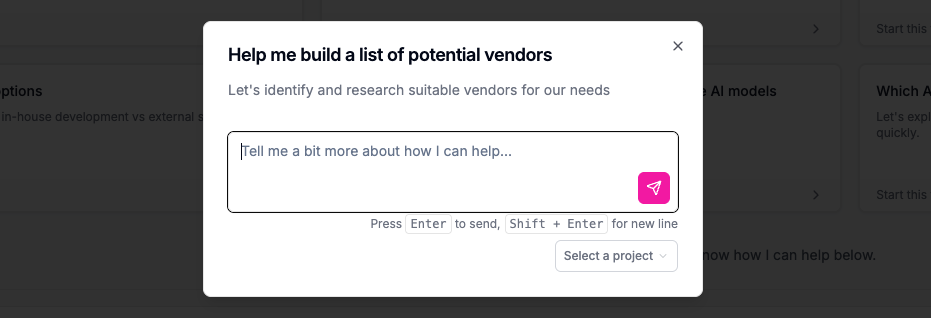
When to Use This Template
Use the Vendor List Template when:- You need to evaluate multiple vendors for an AI procurement decision
- You’re exploring different approaches to solving a business problem, including non-vendor options
- You need to present a rigorous evaluation of alternatives to senior leadership
- You’re preparing to secure budget approval for a formal buying process
- You want to ensure you’ve considered all viable options before committing
Template Structure
The Vendor List Template provides a structured format to organize your vendor evaluation process:Background Section
This opening section provides context for your evaluation:- Business Problem: A clear statement of the challenge you’re trying to address
- Known Vendors: Any pre-existing vendor relationships or vendors already under consideration
- Existing Information: Reference to prior documentation such as problem statements or business cases
Vendor Profiles
For each shortlisted vendor, the template includes:- Vendor Name and Product: Clear identification of the company and specific offering
- Reason for Inclusion: Strategic rationale for including this vendor in your shortlist
- Supporting Evidence: Objective data points such as analyst rankings, peer recommendations, or first-hand experience
- Potential Risks: Identified concerns or limitations specific to this vendor
- Useful Links: Product documentation, pricing information, and other relevant resources
Decision Criteria
A clearly articulated set of evaluation criteria that matters for your specific context:- Industry-specific requirements
- Technical compatibility considerations
- Budget constraints
- Implementation timeline needs
- Support and maintenance requirements
- Integration capabilities
Summary Matrix
A color-coded comparison table that presents key data points across all vendors, enabling:- Side-by-side feature comparison
- Visual highlighting of strengths and weaknesses
- Quick reference for stakeholder discussions
How This Template Helps
The Vendor List Template delivers several key benefits:- Ensures Comprehensive Evaluation: Prompts you to explore all viable options beyond just the most visible vendors
- Builds Objective Decision Criteria: Helps establish transparent evaluation standards
- Simplifies Complex Comparisons: Creates easy-to-understand visual comparisons
- Addresses Alternative Approaches: Includes non-vendor options like improving existing systems or process changes
- Creates Alignment: Provides a reference document that stakeholders can review and discuss
- Demonstrates Due Diligence: Shows leadership that you’ve conducted a thorough evaluation process
Template Example
Here’s a simplified example of what your completed Vendor List might look like:Vendor Short List [Draft]
Background
Business Problem: Our company needs a generative AI solution to improve customer support response times and quality. Known Vendors: Currently using basic chatbots from Intercom. Have received demos from OpenAI and Anthropic. Existing Information: Requirements document completed with input from customer support, legal, and IT teams.Vendor Profiles
OpenAI
- Product: GPT-4 API with custom fine-tuning
- Reason for inclusion: Market leader, extensive capabilities
- Supporting evidence: Used by industry peers, strong developer community
- Potential risks: API rate limitations, pricing uncertainty, data privacy concerns
- Links: openai.com/api
Anthropic
- Product: Claude Enterprise
- Reason for inclusion: Strong safety features, longer context window
- Supporting evidence: Positive security reviews, enterprise-ready features
- Potential risks: Newer company, smaller integration ecosystem
- Links: anthropic.com/claude
In-house development
- Approach: Build custom solution using open-source LLMs
- Reason for inclusion: More control over data and functionality
- Supporting evidence: IT team has ML experience, lower long-term costs
- Potential risks: Development timeline uncertainty, requires specialized skills
- Links: [Internal resource planning document]
Status quo with process improvement
- Approach: Enhanced training and knowledge base for support team
- Reason for inclusion: Low-risk alternative with minimal change management
- Supporting evidence: Recent process audit identified improvement opportunities
- Potential risks: May not scale with growth, limited automation benefits
- Links: [Current process documentation]
Decision Criteria
- Total cost of ownership (3-year projection)
- Data privacy and security compliance
- Integration with existing support systems
- Customization capabilities
- Implementation timeline
- Training requirements
- Scalability
Summary Matrix
| Criteria | OpenAI | Anthropic | In-house | Status quo |
|---|---|---|---|---|
| Est. Annual Cost | $120K | $150K | 80K ongoing | $30K |
| Data Privacy | ⚠️ | ✅ | ✅ | ✅ |
| System Integration | ✅ | ⚠️ | ✅ | ✅ |
| Implementation Time | 2-3 months | 3-4 months | 6-8 months | 1 month |
| Customization | ⚠️ | ⚠️ | ✅ | ❌ |
| Scalability | ✅ | ✅ | ⚠️ | ❌ |
Best Practices
To get the most value from this template:- Include diverse options: Don’t limit yourself to just traditional vendors - consider building in-house, improving current systems, or maintaining status quo
- Be objective: Support claims with evidence rather than opinions
- Quantify where possible: Use numbers for costs, timelines, and other measurable factors
- Highlight risks honestly: Every option has downsides - acknowledging them builds credibility
- Engage stakeholders early: Share the draft with key stakeholders to gather feedback
- Keep it updated: Revisit as you learn more through vendor discussions and deeper research
Next Steps
After completing your Vendor List:- Update your requirements document for each shortlisted vendor
- Plan vendor meetings to validate your assessment
Vendor Meeting Template
Ready to meet with potential vendors? Use our Vendor Meeting template to plan your agenda and questions.

